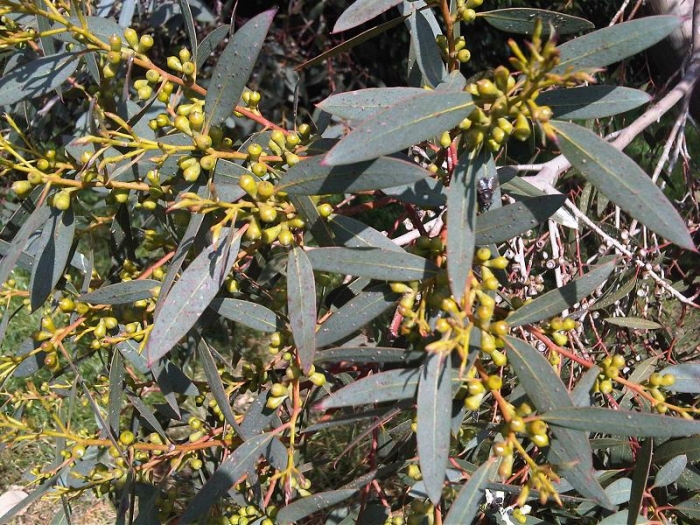Mountain Gum
(Eucalyptus dalrympleana)
Mountain Gum (Eucalyptus dalrympleana)
/
/

Emőke Dénes
CC BY-SA 4.0
Image By:
Emőke Dénes
Recorded By:
Copyright:
CC BY-SA 4.0
Copyright Notice:
Photo by: Emőke Dénes | License Type: CC BY-SA 4.0 | License URL: https://creativecommons.org/licenses/by-sa/4.0 | Uploader: DenesFeri | Publisher: Wikimedia Commons | Title: Myrtales_-_Eucalyptus_dalrympleana_12.jpg | Notes: User created page with UploadWizard |










































Estimated Native Range
Summary
Eucalyptus dalrympleana, commonly known as Mountain Gum, is an evergreen tree endemic to the cool temperate and subalpine regions of Eastern Australia. It thrives in open woodlands and grassy woodland ecosystems, often found on slopes and plateaus. Mountain Gum can reach up to 40 meters (130 feet) in height and is recognized by its smooth, white to yellowish bark that sheds in ribbons, lance-shaped adult leaves, and distinctive white flowers. The flowering period extends from March to June, and the flowers are white and showy, attracting a variety of pollinators. The fruit is a woody capsule that can be cup-shaped, bell-shaped, or hemispherical.
This species is valued for its rapid growth and adaptability to a range of soil types, though it prefers well-drained soils. In cultivation, it is often used as a specimen tree for its attractive bark and canopy, and it is also planted for windbreaks and timber production. Mountain Gum is drought-tolerant once established, making it suitable for areas with low to medium water availability. It has gained the Royal Horticultural Society’s Award of Garden Merit, indicating its exceptional qualities for garden use. While it is hardy down to −15 °C (5 °F), it does prefer some shelter from extreme conditions. Potential problems include susceptibility to eucalyptus gall wasp and Phytophthora root rot. It is important to note that Eucalyptus species can become invasive when grown outside their native range, so gardeners should be cautious about planting them in suitable climates only.CC BY-SA 4.0
This species is valued for its rapid growth and adaptability to a range of soil types, though it prefers well-drained soils. In cultivation, it is often used as a specimen tree for its attractive bark and canopy, and it is also planted for windbreaks and timber production. Mountain Gum is drought-tolerant once established, making it suitable for areas with low to medium water availability. It has gained the Royal Horticultural Society’s Award of Garden Merit, indicating its exceptional qualities for garden use. While it is hardy down to −15 °C (5 °F), it does prefer some shelter from extreme conditions. Potential problems include susceptibility to eucalyptus gall wasp and Phytophthora root rot. It is important to note that Eucalyptus species can become invasive when grown outside their native range, so gardeners should be cautious about planting them in suitable climates only.CC BY-SA 4.0
Plant Description
- Plant Type: Tree
- Height: 50-70 feet
- Width: 15-25 feet
- Growth Rate: Moderate
- Flower Color: White, Cream
- Flowering Season: Summer
- Leaf Retention: Evergreen
Growth Requirements
- Sun: Full Sun
- Water: Low, Medium
- Drainage: Medium
Common Uses
Bee Garden, Bird Garden, Butterfly Garden, Drought Tolerant, Fragrant, Hummingbird Garden
Natural Habitat
Native to cool temperate and subalpine regions of Eastern Australia
Other Names
Common Names: Mountain White Gum, White Gum, Broad-Leaved Ribbon Gum
Scientific Names: , Eucalyptus dalrympleana,
GBIF Accepted Name: Eucalyptus dalrympleana Maiden